Integrated Management, Circular Economy and Reclaimed Water: Keys to Restoring the Long-Term Water Balance in La Marina Alta (Alicante, Spain)
Abstract
1. Introduction and Area of Study
2. Methods and Theoretical Framework: Integrated Resources Management and the Use of Reclaimed Water to Improve Water Governance
3. The Paradox of Abundant and Insufficient Water Resources
- The Mediodía aquifer, which geographically spans Vall de Laguar to Ràfol d’Almúnia and currently presents salinity problems due to marine intrusion, especially in areas near the coast;
- The Almudaina–Segaria aquifer, located in Vall d’Ebo municipality, is in good piezometric conditions, although with risks of contamination due to turbidity during periods of heavy rainfall; it is mainly used for irrigation and urban supply;
- The Parcent aquifer, in Benigembla municipality, has experienced a progressive decrease in piezometric levels since 2015 due to overexploitation;
- Finally, the Albuerca–Mustalla aquifer, located in Vall de Gallinera municipality, is currently in a critical situation in some areas, with sustainability problems in the medium-term.
4. Circular Economy and Reclaimed Water: Proposals for the Long-Term Water Balance in La Marina Alta
5. The Institutional Role of the Consortium in the Potential Integrated Water Resources Management in La Marina Alta
6. Conclusions
Author Contributions
Funding
Institutional Review Board Statement
Informed Consent Statement
Data Availability Statement
Acknowledgments
Conflicts of Interest
Abbreviations
| AVAMET | Associació Valenciana de Meteorologia (Valencian Association of Meteorology) |
| CAMB | Consorcio de Aguas de La Marina Baja (Water Consortium of La Marina Baja) |
| CASAMA | Consorcio de Abastecimiento y Saneamiento de Aguas de los Municipios de La Marina Alta (Supply and Sanitation Water Consortium of La Marina Alta) |
| CHJ | Confederación Hidrográfica del Júcar (Water Basin Authority of Júcar River) |
| EPSAR | Entidad Pública de Saneamiento de Aguas Residuales de la Comunidad Valenciana (Public Entity for Wastewater Treatment of the Valencian Region) |
| IWRM | Integrated Water Resources Management |
| MBR | Membrane bioreactor |
| RCP | Representative Concentration Pathway |
| RD | Real Decreto (Royal Decree) |
| RO | Reverse osmosis |
| UN | United Nations |
| UV | Ultraviolet |
| WWTP | Wastewater treatment plant |
References
- Melgarejo Moreno, J.; Lopez Ortiz, M.-I.; Molina Giménez, A. La Economía Circular y el Sector del Agua en España. Análisis Jurídico-Económico; Tirant lo Blanch: Valencia, Spain, 2023. (In Spanish) [Google Scholar]
- United Nations. The United Nations World Water Development Report 2021: Valuing Water; UNESCO: Paris, France, 2021. [Google Scholar]
- Melgarejo Moreno, J.; Molina Giménez, A. La Mancomunidad de los Canales del Taibilla en la Provincia de Alicante; Universidad de Alicante: Alicante, Spain, 2017. (In Spanish) [Google Scholar]
- OIKOS. El agua en España: Diagnóstico Integral de un Desafío Urgente y Compartido; OIKOS: Barcelona, Spain, 2024; Available online: https://www.entrenosdigital.com/media/entrenosagra/files/2024/11/18/Informe%20OIKOS%20-%20El%20Agua%20en%20Espa%C3%B1a.pdf (accessed on 12 February 2025). (In Spanish)
- Asociación Española de Desalación y Reutilización (AEDyR). Cifras de Reutilización de agua en España. Available online: https://aedyr.com/cifras-reutilizacion-agua-espana/ (accessed on 7 March 2025).
- Ellen MacArthur Foundation. Completing the Picture: How the Circular Economy Tackles Climate Change. Ellen MacArthur Foundation. 2019. Available online: https://ellenmacarthurfoundation.org/completing-the-picture (accessed on 7 March 2025).
- Padilla, A.; Teulada Moraira, Primer Pueblo de la Comunitat que se Queda sin agua Potable por la Sequía. Levante-EMV. 2024. Available online: https://www.levante-emv.com/marina/2024/08/02/teulada-moraira-queda-agua-potable-106467533.html (accessed on 10 February 2025). (In Spanish).
- Simó Noguera, C.X.; Giner Monfort, J. Un peu dins, un peu fora. La Inmigració de Residents Europeus al Municipi de Teulada; Universitat de València: Valencia, Spain, 2012; (In Valencian language). [Google Scholar]
- Instituto Geológico y Minero de España (IGME); Diputación de Alicante. Desarrollo Sostenible, Uso, Conjunto y Gestión Integral de Recursos Hídricos: Estudios y Actuaciones Realizadas en la Provincia de Alicante; Instituto geológico y minero de España (IGME) and Diputación de Alicante: Alicante, Spain, 2015. (In Spanish) [Google Scholar]
- ASAJA Alicante; Diputación de Alicante. Boletín Estadístico de la Agricultura y la Ganadería de la Provincia de Alicante; ASAJA Alicante and Diputación de Alicante: Alicante, Spain, 2014. (In Spanish) [Google Scholar]
- Agencia Estatal de Meteorología (AEMET). Comportamiento de las Precipitaciones en España y Periodos de Sequía (Periodo 1961–2018); Agencia Estatal de Meteorología, Ministerio para la Transición Ecológica y el Reto Demográfico: Madrid, Spain, 2020; Available online: https://www.aemet.es/documentos/es/conocermas/recursos_en_linea/publicaciones_y_estudios/publicaciones/NT32_AEMET/NT_32_Comportamiento_precipitaciones.pdf (accessed on 7 April 2025). (In Spanish)
- Medina García, A. (Consorcio de Aguas de La Marina Alta, Alicante, Spain). Personal communication, 2024.
- Melgarejo Moreno, J.; Fernández Mejuto, M. El Agua en la Provincia de Alicante; Diputación Provincial de Alicante: Alicante, Spain, 2020. (In Spanish) [Google Scholar]
- Confederación Hidrográfica del Júcar (CHJ). Memoria—Anejo 2. Inventario de Recursos Hídricos. Ciclo de Planificación 2022–2027; Confederación Hidrográfica del Júcar, Ministerio para la Transición Ecológica y el Reto Demográfico: Valencia, Spain, 2023; Available online: https://www.chj.es/es-es/medioambiente/planificacionhidrologica/Documents/Plan-Hidrologico-cuenca-2021-2027/PHC/Version%20Final/PHJ2227_Anejo02_RRHH_2023_01_24.pdf (accessed on 18 February 2025). (In Spanish)
- Melgarejo Moreno, J.; Lopez Ortiz, M.-I.; Fernández Aracil, P. Inundaciones y Sequías: Análisis Multidisciplinar para Mitigar el Impacto de los Fenómenos Climáticos Extremos; Universidad de Alicante: Alicante, Spain, 2021; Available online: http://hdl.handle.net/10045/118411 (accessed on 28 February 2025). (In Spanish)
- Sánchez Pérez, C.; Lopez Ortiz, M.-I.; Fernández Aracil, P. La Marina Baja Water Consortium (1950–1978): Hydro-economic model of water governance behind tourism development in Benidorm (Spain). Water 2024, 16, 1832. [Google Scholar] [CrossRef]
- Spain. Real Decreto Legislativo 1/2001, de 20 de julio, por el que se Aprueba el Texto Refundido de la Ley de Aguas (Water Law). Boletín Oficial del Estado 2001, 176, 1–68. Available online: https://www.boe.es/eli/es/rdlg/2001/07/20/1/con (accessed on 28 February 2025).
- Spain. Ley 10/2001, de 5 de julio, del Plan Hidrológico Nacional (National Hydrological Plan). Boletín Oficial del Estado 2001, 161, 1–44. Available online: https://www.boe.es/eli/es/l/2001/07/05/10/con (accessed on 28 February 2025).
- European Union. Regulation (EU) 2020/741 of the European Parliament and of the Council of 25 May 2020 on minimum requirements for water reuse. Off. J. Eur. Union 2020, L177, 32–55. [Google Scholar]
- Diputación de Alicante. Pacto Provincial por el Agua en Alicante (Provincial Water Pact in Alicante); Diputación de Alicante: Alicante, Spain, 2018; Available online: https://www.diputacionalicante.es/wp-content/uploads/2020/06/PACTO-PROVINCIAL-DEL-AGUA-ACUERDO-DEFINITIVO.pdf (accessed on 3 February 2025). (In Spanish)
- Paris, M. La seguridad Hídrica y los Objetivos de Desarrollo Sostenible. Manual de Capacitación para Tomadores de Decisión; UNESCO: Paris, France; Montevideo, Uruguay, 2020; Available online: https://unesdoc.unesco.org/ark:/48223/pf0000374917.locale=es (accessed on 13 January 2025). (In Spanish)
- European Environment Agency. Water reuse. Climate-ADAPT. Available online: https://climate-adapt.eea.europa.eu/en/metadata/adaptation-options/water-recycling (accessed on 17 April 2025).
- Delgado Ramos, F. (University of Granada, Granada, Spain). Personal communication. 2025. Available online: https://multimedia.europarl.europa.eu/en/webstreaming/envi-committee-meeting_20250127-1500-COMMITTEE-ENVI (accessed on 7 April 2025).
- European Union. Directive 2000/60/EC of the European Parliament and of the Council of 23 October 2000 establishing a framework for Community action in the field of water policy. Off. J. Eur. Union 2000, L327, 1–73. [Google Scholar]
- International Environmental Law Research Centre. The Dublin Statement on Water and Sustainable Development; International Environmental Law Research Centre: Geneva, Switzerland, 1992; Available online: www.ielrc.org/content/e9209.pdf (accessed on 24 February 2025).
- Confederación Hidrográfica del Júcar (CHJ). Normativa. Ciclo de Planificación 2022–2027 (Júcar River Basin Hydrological Plan); Confederación Hidrográfica del Júcar, Ministerio para la Transición Ecológica y el Reto Demográfico: Valencia, Spain, 2023; Available online: https://www.chj.es/es-es/medioambiente/planificacionhidrologica/Paginas/PHC-2021-2027-Indice.aspx (accessed on 18 February 2025). (In Spanish)
- Hagenvoort, J.; Ortega-Reig, M.; Botella, S.; García, C.; de Luis, A.; Palau-Salvador, G. Reusing Treated Waste-Water from a Circular Economy Perspective—The Case of the Real Acequia de Moncada in Valencia (Spain). Water 2019, 11, 1830. [Google Scholar] [CrossRef]
- Gil-Meseguer, E.; Bernabé-Crespo, M.B.; Gómez-Espín, J.M. Recycled Sewage-A Water Resource for Dry Regions of Southeastern Spain. Water Resour. Manag. 2019, 33, 725–737. [Google Scholar] [CrossRef]
- Nikolaou, G.; Neocleous, D.; Christou, A.; Kitta, E.; Katsoulas, N. Implementing Sustainable Irrigation in Water-Scarce Regions under the Impact of Climate Change. Agronomy 2020, 10, 1120. [Google Scholar] [CrossRef]
- Naidoo, D.; Nhamo, L.; Lottering, S.; Mpandeli, S.; Liphadzi, S.; Modi, A.T.; Trois, C.; Mabhaudhi, T. Transitional Pathways towards Achieving a Circular Economy in the Water, Energy, and Food Sectors. Sustainability 2021, 13, 9978. [Google Scholar] [CrossRef]
- Liu, Q.; Yang, L.; Yang, M. Digitalisation for water sustainability: Barriers to implementing circular economy in smart water management. Sustainability 2021, 13, 11868. [Google Scholar] [CrossRef]
- Consorcio de Aguas de La Marina Alta (CASAMA). Estudio de Viabilidad del Consorcio de Abastecimiento y Saneamiento de Aguas de los Municipios de La Marina Alta; Diputación de Alicante: Alicante, Spain, 2014. [Google Scholar]
- Associació Valenciana de Meteorologia (AVAMET). Available online: https://www.avamet.org/ (accessed on 20 January 2025).
- Confederación Hidrográfica del Júcar (CHJ). Informe de Seguimiento de la Sequía—Diciembre 2024; Confederación Hidrográfica del Júcar, Ministerio para la Transición Ecológica y el Reto Demográfico: Valencia, Spain, 2024; Available online: https://www.chj.es/es-es/medioambiente/gestionsequia/Documents/Informes%20Seguimiento/Informe%20seguimiento%20sequía%20-%20diciembre%202024/Informe%20sequia.pdf (accessed on 18 February 2025). (In Spanish)
- Confederación Hidrográfica del Júcar (CHJ). Plan Especial de Sequía de la Demarcación Hidrográfica del Júcar; Confederación Hidrográfica del Júcar, Ministerio para la Transición Ecológica y el Reto Demográfico: Valencia, Spain, 2023; Available online: https://www.chj.es/es-es/medioambiente/gestionsequia/Documents/Plan%20Especial%20Sequia%202023/PES_EsAE_Septiembre_2024.pdf (accessed on 18 February 2025). (In Spanish)
- Pool, M.; Abarca, E.; Carrera, J. Simplificaciones en la modelación de la intrusión marina: Validez y alcance. Boletín Geológico y Minero 2007, 118, 593–608. (In Spanish) [Google Scholar]
- MACMA. Presa d’Ísber; MACMA. Seu Mancomunitat Comarcal de la Marina Alta: Ondara, Spain, 2024; Available online: https://macma.org/turismo/patrimonio/presa-disber (accessed on 12 February 2025). (In Spanish)
- Torregrosa, T. La Gestión del Agua en la Marina Baja (Alicante); Corts Valencianes: Valencia, Spain, 2009; Available online: https://www.cortsvalencianes.es/sites/default/files/migrated/publication_book/doc/temas19.pdf (accessed on 17 December 2024). (In Spanish)
- Entidad Pública de Saneamiento de Aguas Residuales de la Comunidad Valenciana (EPSAR). Memoria de Gestión 2023; Generalitat Valenciana: Valencia, Spain, 2024; Available online: https://www.epsar.gva.es/ (accessed on 10 March 2025). (In Spanish)
- European Union. Council Directive 91/271/EEC of 21 May 1991 concerning urban waste-water treatment. Off. J. Eur. Union 1991, L135, 40–52. [Google Scholar]
- Spain. Real Decreto 1620/2007, de 7 de diciembre, por el que se establece el régimen jurídico de la reutilización de las aguas depuradas. Boletín Oficial del Estado 2007, 294, 50639–50661. Available online: https://www.boe.es/eli/es/rd/2007/12/07/1620 (accessed on 28 February 2025).
- Mediterranean Expert Group on Climate and Environmental Change (MedECC). Risks Associated to Climate and Environmental Changes in the MEDITERRANEAN REGION. Preliminary Assessment by the MedECC Network Science-Policy Interface. 2019. Available online: https://www.medecc.org/medecc-booklet-isk-associated-to-climate-and-environmental-changes-in-the-mediterranean-region/ (accessed on 17 April 2025). (In Spanish).
- Confederación Hidrográfica del Júcar (CHJ). Memoria—Anejo 14. Riesgos Asociados al Cambio Climático y Adaptación. Ciclo de Planificación 2022–2027; Confederación Hidrográfica del Júcar, Ministerio para la Transición Ecológica y el Reto Demográfico: Valencia, Spain, 2023; Available online: https://www.chj.es/es-es/medioambiente/planificacionhidrologica/Documents/Plan-Hidrologico-cuenca-2021-2027/PHC/Version%20Final/PHJ2227_Anejo14_CC_2023_01_24.pdf (accessed on 24 May 2025). (In Spanish)
- Rodríguez Hernández, L.M.C.R.; Solís García-Barbón, L.; Máximo Marín, M.; Fernández Mejuto, M.; Castillo Sánchez, V.M.; Hernández Bravo, J.A. Propuesta del plan de construcción de presas de recarga en la provincia de Alicante (España). Boletín Geológico y Minero 2009, 120, 157–168. Available online: https://www.igme.es/boletin-geologico/volumen-120-numero-2/ (accessed on 28 February 2025).
- Fernández, D. El Parque Natural que se Muere Poco a poco en Alicante: La Generalitat ya Califica de “Desastre” que se Hayan Secado Miles de pinos del Montgó. Infobae. 2024. Available online: https://www.infobae.com/espana/2024/08/31/el-parque-natural-que-se-muere-poco-a-poco-en-alicante-la-generalitat-ya-califica-de-desastre-que-se-hayan-secado-miles-de-pinos-del-montgo/ (accessed on 10 February 2025). (In Spanish).
- European Environment Agency. Accelerating the Circular Economy in Europe: State and Outlook 2024; Publications Office of the European Union: Copenhagen, Denmark, 2024; Available online: https://www.eea.europa.eu/en/analysis/publications/accelerating-the-circular-economy (accessed on 28 January 2025).
- Alonso Alonso, L. Biorreactores de Membrana (MBR), Biorreactores de Electro Membrana (eMBR) y Biorreactores de Membrana Dinámica Autoformante (SFDMBR); Chemical engineering final project, University of Valladolid: Valladolid, Spain, 2020; Available online: http://uvadoc.uva.es/handle/10324/45063 (accessed on 28 February 2025). (In Spanish)
- Spain. Real Decreto 1085/2024, de 22 de octubre, por el que se aprueba el Reglamento de reutilización del agua y se modifican diversos reales decretos que regulan la gestión del agua. Boletín Oficial del Estado 2024, 256, 50639–50661. Available online: https://www.boe.es/eli/es/rd/2024/10/22/1085/con (accessed on 28 February 2025).
- San Sebastián Sauto, J.; Fernández Escalante, E.; Henao Casas, J.D.; Calero Gil, R. La recarga gestionada de acuíferos en España: Previsiones en materia de planificación y gobernanza en el corto plazo. In Proceedings of the Congreso Nacional del Medio Ambiente (CONAMA), Madrid, Spain, 31 May–3 June 2020; Available online: https://www.conama11.vsf.eseconomy (accessed on 4 February 2025).
- Albaladejo Ruiz, A. Optimización del agua no registrada (ANR) en las ciudades inteligentes. In Congreso Nacional del Agua Orihuela: Innovación y Sostenibilidad; Melgarejo Moreno, J., Ed.; Universidad de Alicante: Alicante, Spain, 2019; pp. 1539–1550. (In Spanish) [Google Scholar] [CrossRef]
- Torregrosa, T.; Sevilla, M. Economic issues in the integrated management of water resource model (IWRM) and the management unit in a territory affected by several basins: The case of the Spanish southeast. Int. J. Environ. Impacts 2019, 2, 346–355. [Google Scholar] [CrossRef]
- Dénia City Council. Minutes of the Municipal Plenary Session; Dénia City Council: Dénia, Spain, 2024; Available online: www.denia.es (accessed on 17 January 2025). (In Spanish)
- Melgarejo Moreno, J.; Lopez Ortiz, M.-I.; Fernández Aracil, P. Crecimiento económico y garantía del abastecimiento: La Mancomunidad de los Canales del Taibilla (MCT). Canelobre 2019, 70, 260–275. (In Spanish) [Google Scholar]
- Confederación Hidrográfica del Júcar (CHJ). La Confederación Hidrográfica del Júcar Declara la Situación Excepcional por Sequía Extraordinaria en Toda la Demarcación; Confederación Hidrográfica del Júcar, Ministerio para la Transición Ecológica y el Reto Demográfico: Valencia, Spain, 2024; Available online: https://www.chj.es/es-es/ciudadano/salaprensa/Paginas/CHJ-declara-situacion-excepcional-sequía-extraordinaria-toda-Demarcación-.aspx (accessed on 3 February 2025). (In Spanish)
- Manez, E. In Spain’s Drought-Hit Costa Blanca, People Queue for Bottled Water. Reuters. 2024. Available online: https://www.reuters.com/world/europe/spains-drought-hit-costa-blanca-people-queue-bottled-water-2024-08-21/ (accessed on 10 February 2025). (In Spanish).
- Centro Regional de Información de las Naciones Unidas (UNRIC). La DANA que Asoló Valencia Revela la Urgencia de la Acción Climática. UNRIC. 2024. Available online: https://unric.org/es/la-dana-en-valencia-y-el-cambio-climatico/ (accessed on 31 January 2025). (In Spanish).
- European Environment Agency. European Climate Risk Assessment; Publications Office of the European Union: Copenhagen, Denmark, 2024; Available online: https://www.eea.europa.eu/en/analysis/publications/european-climate-risk-assessment (accessed on 28 January 2025).
- United Nations. The United Nations World Water Development Report 2015: Water for a Sustainable World; UNESCO: Paris, France, 2015; Available online: https://unesdoc.unesco.org/ark:/48223/pf0000232272 (accessed on 28 February 2025).
- Fundación CONAMA. Agua y economía circular. In Proceedings of the Congreso Nacional del Medio Ambiente (CONAMA), Madrid, Spain, 26–29 November 2018; Available online: https://www.conama2018.org (accessed on 4 February 2025).
- Spain. Ley 7/1985, de 2 de abril, Reguladora de las Bases del Régimen Local (Local Government Bases Act). Boletín Oficial del Estado 1985, 80, 8941–8954. Available online: https://www.boe.es/eli/es/l/1985/04/02/7/con (accessed on 18 December 2024). (In Spanish).
- Pérez Pérez, E. La Figura del Consorcio Aplicada a la Gestión de las Aguas Subterráneas; Confederación Hidrográfica del Segura: Murcia, Spain, 1983. (In Spanish) [Google Scholar]
- Ostrom, E. Beyond markets and states: Polycentric governance of complex economic systems. Am. Econ. Rev. 2009, 100, 641–672. [Google Scholar] [CrossRef]
- Gleick, P.H. The World’s Water: The Biennial Report on Freshwater Resources; Island Press: Washington, DC, USA, 2022. [Google Scholar]
- Ostrom, E. Governing the Commons. The Evolution of Institutions for Collective Action; Cambridge University Press: Cambridge, UK, 1990. [Google Scholar]
- Morote Seguido, Á.F. Los grandes sistemas de abastecimiento de agua en el litoral de Alicante. Anales de Geografía 2015, 35, 97–120. (In Spanish) [Google Scholar] [CrossRef]

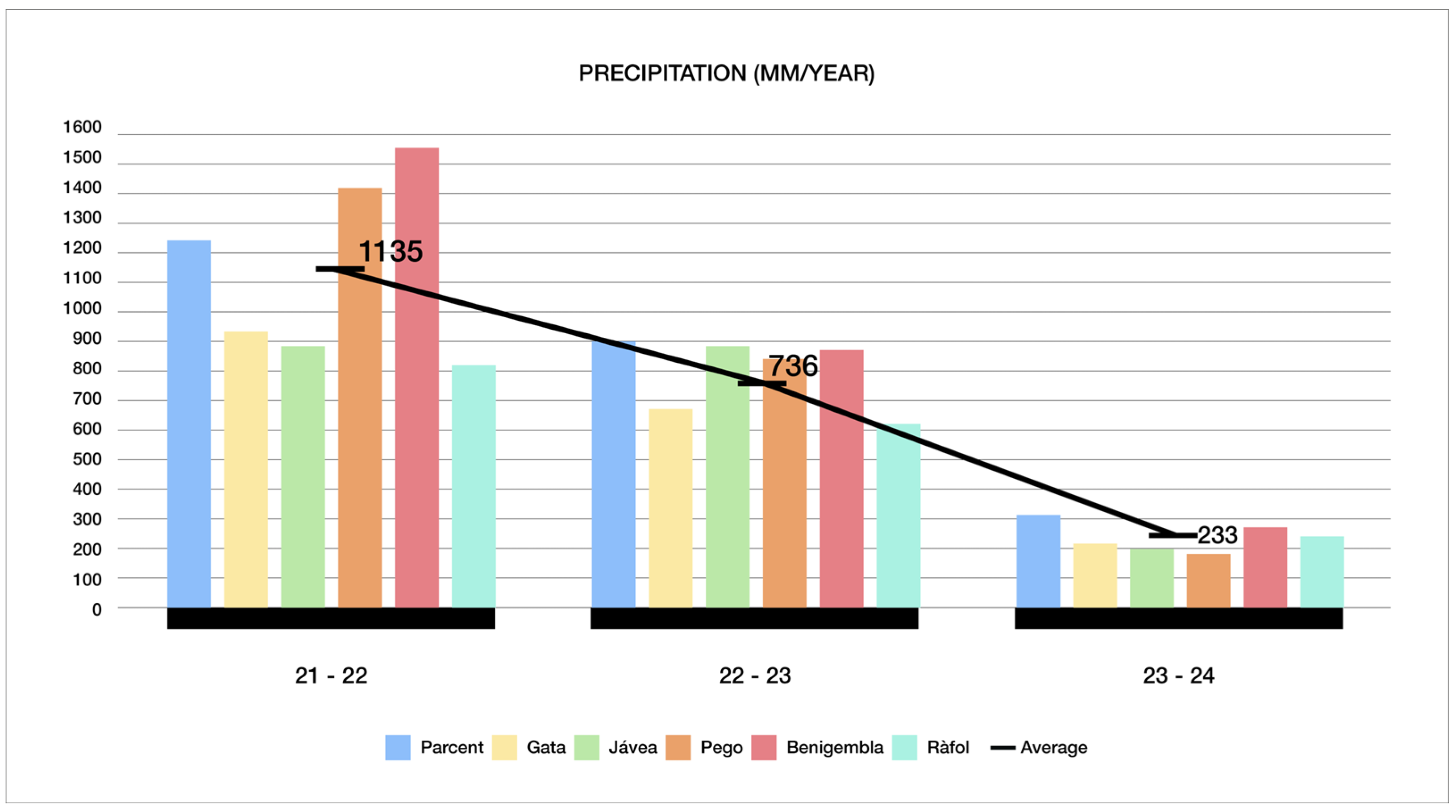
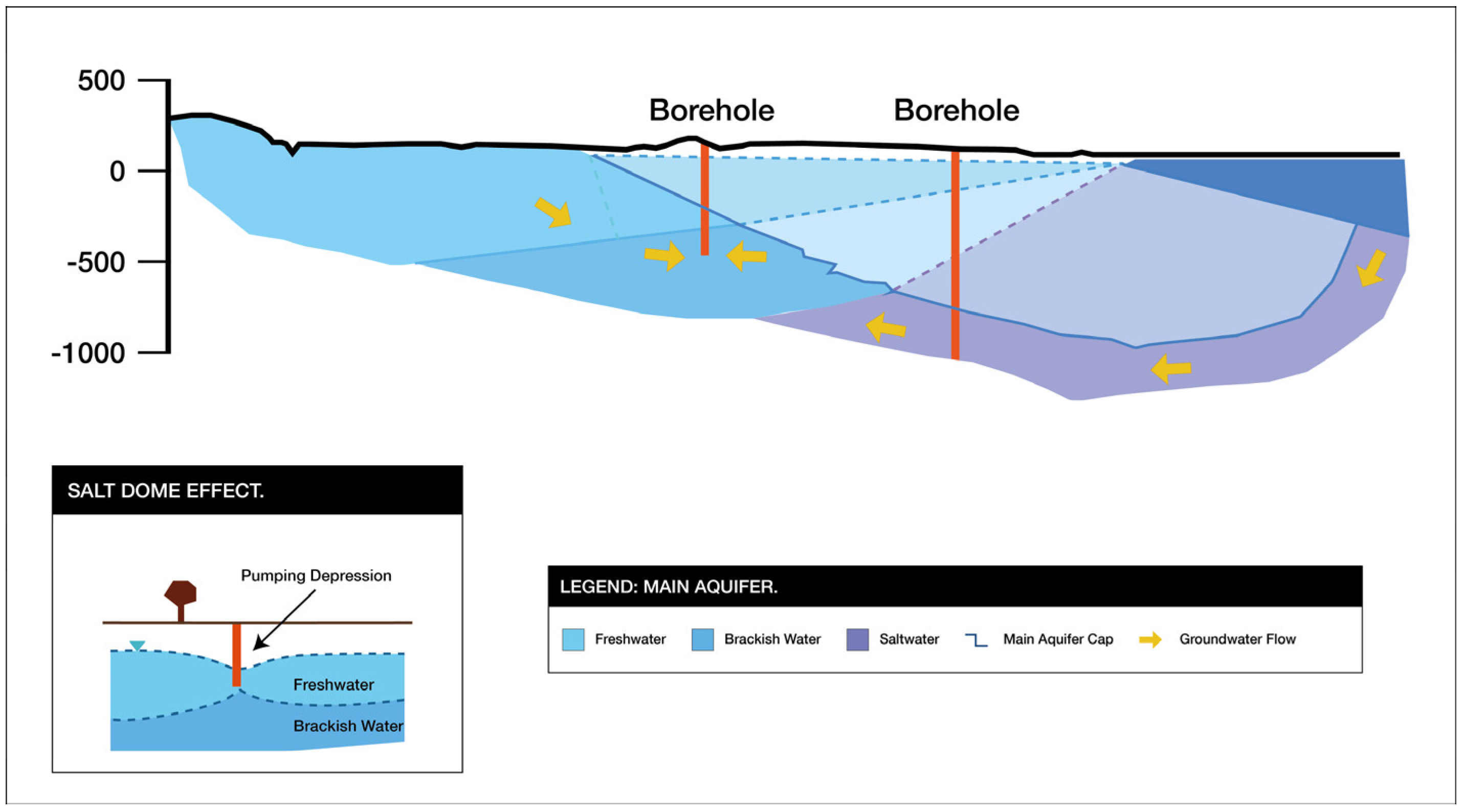
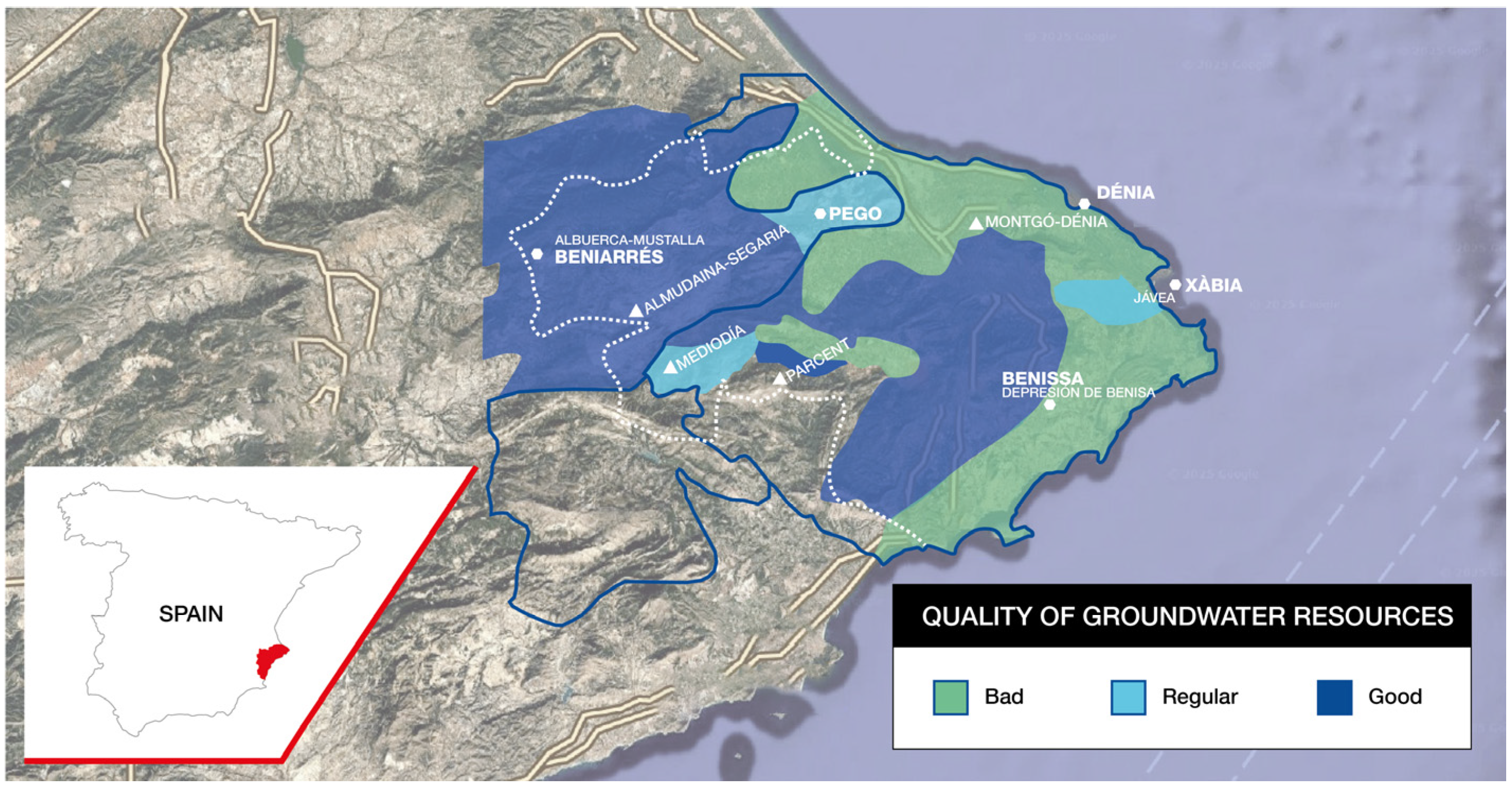
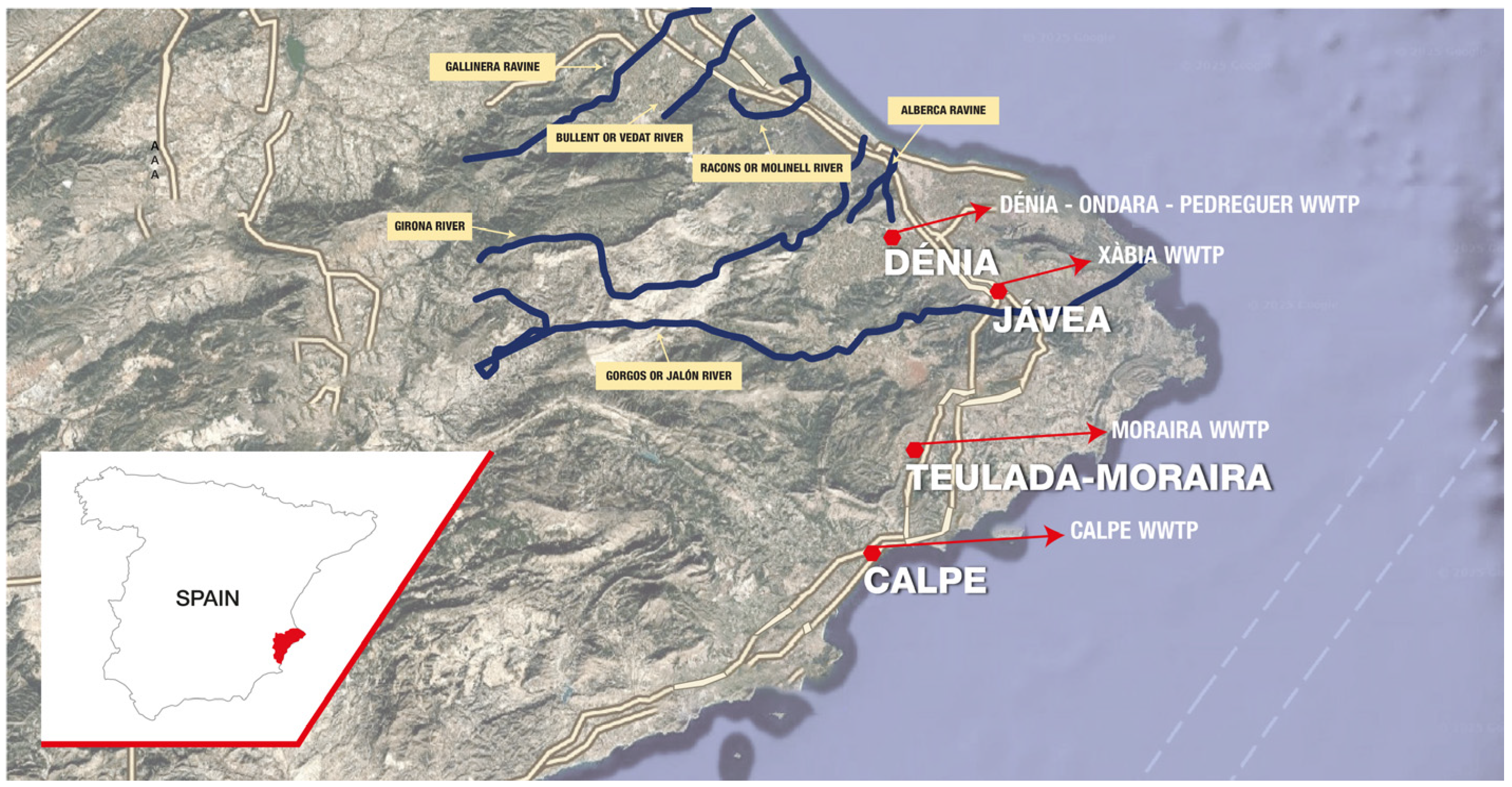
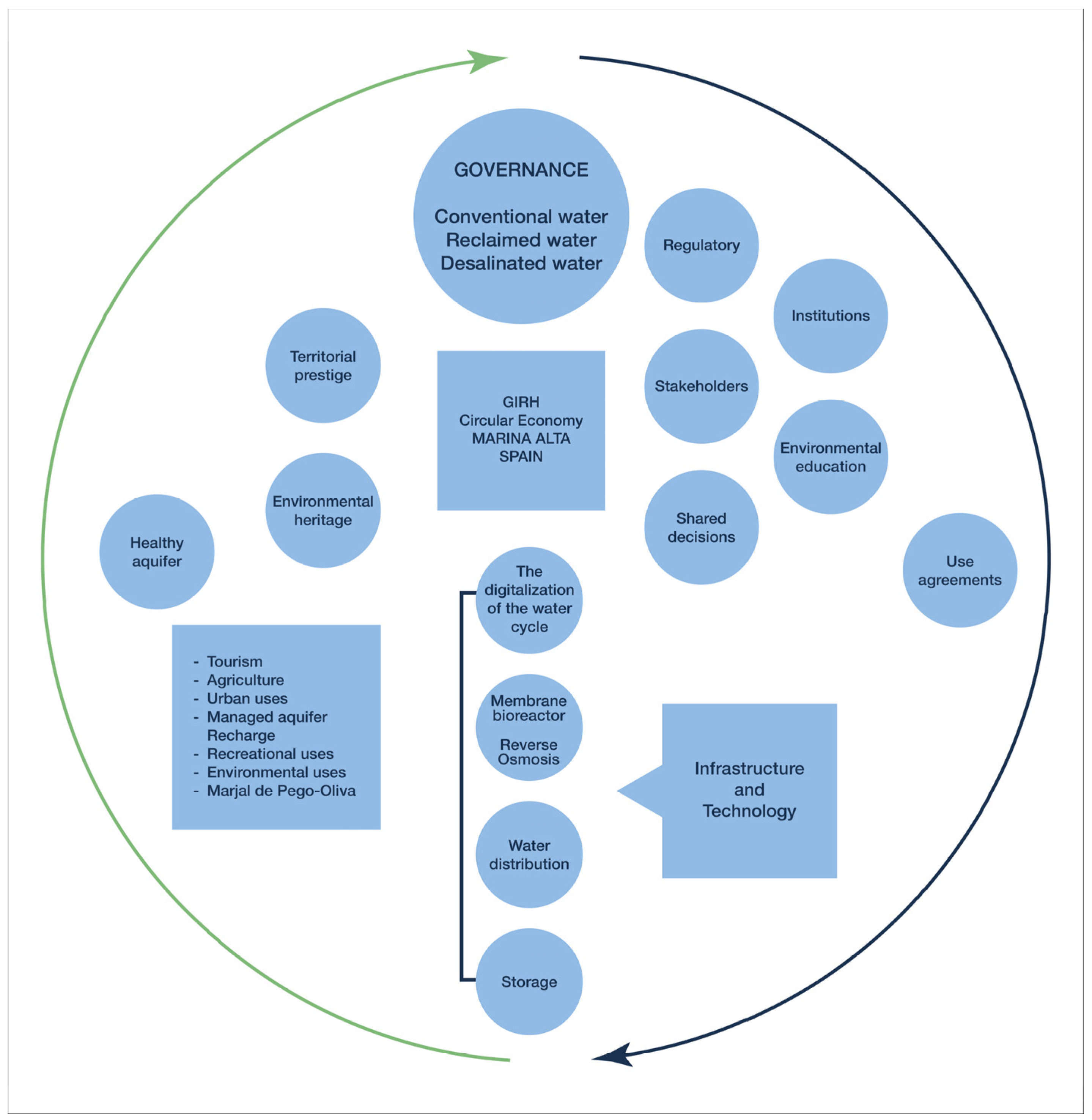
| Usage | Code | Name of Demand Unit | Surface Water (hm3/year) | Groundwater (hm3/year) | Reclaimed (hm3/year) | Desalinated (hm3/year) |
|---|---|---|---|---|---|---|
| Urban | U7005 | Alfaro–Segaria, Ondara–Dénia and other water supplies. | 0 | 8.4 | 0 | 0 |
| Urban | U7010 | Dénia supply | 7.8 | 6 | 0 | 0 |
| Urban | U7015 | Supplies of Mediodía, Gorgos and others | 0 | 0.6 | 0 | 0 |
| Urban | U7020 | Supplies of the Teulada–Benitatxell Municipal Water Consortium for Drinking Water Supply | 0 | 4.3 | 0 | 0 |
| Urban | U7025 | Benissa–Senija User Community Supplies | 0 | 2.5 | 0.3 | 0 |
| Urban | U7030 | Water supplies of the Vall del Pop Irrigation and Users’ Community | 0 | 1.3 | 0 | 0 |
| Urban | U7035 | Supplies of the Community of Calpe, Murla and Vall de Laguar-Pozo Lucifer | 0.2 | 6.9 | 0 | 0 |
| Urban | U7040 | Rest of supplies in La Marina Alta | 0.2 | 1.4 | 0 | 0 |
| Urban | U7045 | Jávea water supply | 0 | 3.4 | 0 | 3.6 |
| Agricultural | A7005 | Irrigable area of Oliva, Pego and Gallinera basin. | 14.4 | 20.7 | 0 | 0 |
| Agricultural | A7010 | Irrigable area of the Girona River and Alberca Ravine | 5.1 | 16.5 | 0.3 | 0 |
| Agricultural | A7015 | Groundwater irrigation of the Alberca–Gorgos Inter-river Basin | 0 | 3.2 | 0 | 0 |
| Agricultural | A7020 | Irrigable area of the Gorgos River | 1 | 3.6 | 0 | 0 |
| Agricultural | A7025 | Rest of irrigated land in La Marina Alta area | 0 | 0.8 | 0 | 0 |
| Agricultural | A7030 | Irrigation of the Pla de Xàbia | 0 | 0.9 | 0 | 0 |
| Industrial | I7005 | La Marina Alta system industries | 0 | 1 | 0 | 0 |
| Recreational | O7005 | Oliva Nova Golf Club | 0 | 0.5 | 0 | 0 |
| Recreational | O7010 | La Sella Golf | 0 | 0 | 0.6 | 0 |
| Recreational | O7015 | Pego Golf Sector | 0 | 0 | 0.6 | 0 |
| Total maximum allocations planned | 28.7 | 82 | 1.8 | 3.6 | ||
| Scope | Type of Measure | Components of the Measure | Opportunities and Benefits | Weaknesses and Barriers | Financing and Participants Involved | Source of Energy |
|---|---|---|---|---|---|---|
| Governance | Modification of CASAMA’s statutes | Incorporation of users (neighborhood associations, irrigators and third sector) as members of CASAMA together with the consortium municipalities, the Valencian Regional Government and the Provincial Council of Alicante. | Dialogue, transparency, inclusive management and shared decisions. | Historical conflicts between the inland and the coast or between agricultural/environmental activities and tourism. Institutional fragmentation and lack of integration of municipalities. Risk of politicization. | Without any additional costs. Technicians from the municipalities and administrations composing the consortium. Stakeholders. | - |
| Modification of CASAMA’s statutes | Creation of the urban water cycle observatory. | Analysis of resources and consumption (tracking indicators). Awareness campaigns, training and elaboration of consumer guides. Alignment with strategic plans such as the Spanish Circular Economy Strategy. | Poor culture of institutional collaboration and historical conflicts among users. Lack of financing. Need for investment in expensive technology. Risk of politicization. | Monetary contributions of administrations composing the consortium. Public–private partnership. | - | |
| Modification of CASAMA’s statutes | Creation of the water technical committee of the district. | Technical advice, reporting, collaboration between administrations, universities and companies, elaboration of plans (including cost-benefit analysis): drought, infrastructure and storage. | Historical conflicts between the inland and the coast or between agricultural/environmental activities and tourism. Lack of commitment on the part of the consortium member municipalities. | Without any additional costs. Technicians from the municipalities and administrations constituting the consortium. | - | |
| Modification of CASAMA’s statutes | Integration of existing associations of municipalities and other supralocal management bodies within CASAMA. | Interoperability of management bodies. | Institutional fragmentation and lack of integration of municipalities. Lack of trust in CASAMA. | Without any additional costs. Technicians from the municipalities and administrations constituting the consortium. | - | |
| Compliance with CASAMA’s statutes | Assignment of municipal flows to CASAMA. | Rational and efficient use of water resources at district level. | Institutional fragmentation and lack of integration of municipalities. Lack of trust in CASAMA. | Without any additional costs. Technicians from the municipalities and administrations constituting the consortium. | - | |
| Modification of CASAMA’s statutes | Minimum public tariffs for agricultural, recreational and water supply uses. | Feasibility of public–private investments and legal certainty. | Institutional fragmentation and lack of integration of municipalities. Lack of trust in CASAMA. Its implementation would have an initial social rejection. | Without any additional costs. Technicians from the municipalities and administrations constituting the consortium. | - | |
| Modification of CASAMA’s statutes | Contracts of use. | Establish volumes, economic compensation and viability of infrastructure investments with public–private partnerships. | Institutional fragmentation and lack of integration of municipalities. Distrust in CASAMA. To be approached with individual projects. | Without any additional costs. Technicians from the municipalities and administrations constituting the consortium. | - | |
| Modification of CASAMA’s statutes | Collaboration with universities and start-ups. | Knowledge transfer. | Seeking incentives. | Without any additional costs. Technicians from the municipalities and administrations constituting the consortium. Public–private partnership. | - | |
| Technology and infrastructure | MBR | Implementation of tertiary treatment at Calpe WWTP, Xàbia WWTP, Dénia–Ondara–Pedreguer WWTP and Moraira WWTP to reach 11.7 hm3 of reclaimed water. | Product water in accordance with European framework legislation, advanced treatment and increased flow of reclaimed water, with sludge reduction. | High energy consumption and cost. | European funds. Spanish Ministry of Ecological Transition, Valencian Regional Government and Provincial Council of Alicante. | Cogeneration with biogas, photovoltaic, gasification and pyrolysis. |
| RO | Implementation of ROs at Calpe WWTP, Xàbia WWTP, Dénia–Ondara–Pedreguer WWTP and Moraira WWTP. | Decrease in conductivity and possibility of agricultural, urban industrial and recreational uses. | High energy consumption and cost. | European funds. Spanish Ministry of Ecological Transition, Valencian Regional Government and Provincial Council of Alicante. | Cogeneración con biogás Fotovoltaica Gasificación y pirólisis. | |
| Urban water cycle digitalization and environmental health | Artificial intelligence, big data processing, digital twins and Internet of things | Demand forecasting and leak detection, weather forecasting, pattern identification, incident and conductivity monitoring or simulation of hazard scenarios (such as drought). | Impact on municipal tariffs, depending on the percentage of public subsidy. | Municipal revenues. European funds. Spanish Ministry of Ecological Transition, Valencian Regional Government and Provincial Council of Alicante. | - | |
| Sanitation and sewerage networks | Modernization of the urban drainage system, sewerage network and sanitation services. Especially in coastal municipalities where saline intrusion is a challenge. | Prevention and reduction of environmental and public health impacts by reducing discharge. Control of marine intrusion and increased potential reclaimed water resources. | Nuisances to neighbors during building processes. | European funds. Spanish Ministry of Ecological Transition, Valencian Regional Government and Provincial Council of Alicante. | - | |
| Desalination | Expansion of the desalination plant in Xàbia and new desalination plants: Calpe, Teulada–Benitatxell and Dénia. | More efficient use, increased resources during periods of high demand and guarantee of supply in scenarios of shortage or drought. | High energy consumption and cost. | European funds. Spanish Ministry of Ecological Transition, Valencian Regional Government and Provincial Council of Alicante. | Photovoltaic. | |
| Water purification | New filtration plants in: Vall de Laguar, Vall de Gallinera, Gata de Gorgos, Alcalali and Tormos. | Improved water quality and suitability for supply, agricultural use or discharge into the inland public water domain. Minimized downstream processes. Environmental benefits in ecosystems or aquifers and public health. | Excessive turbidity of the resources in some catchments due to decalcifying clays. | European funds. Spanish Ministry of Ecological Transition, Valencian Regional Government and Provincial Council of Alicante. | Photovoltaic. | |
| Transport and distribution networks | Some of the main required actions would be the connection of the Xàbia desalination plant to Poble Nou Benitatxell (through the so-called Camí Vell de Teulada); connection of WWTPs to new urban reservoirs; connection of the Dénia–Ondara–Pedreguer WWTP to the Pego aquifer; interconnection of the wells of Senija de Gata de Gorgos, Canor de Benissa and the Senija well; Vall del Pop pipeline. | Full exploitation of the potential capacity offered by the Xàbia desalination plant; reduction in aquifer resources; reuse of reclaimed water for urban, agricultural and recreational uses; environmental recovery of natural park of La Marjal Pego–Oliva. | High investment cost. | European funds. Spanish Ministry of Ecological Transition, Valencian Regional Government and Provincial Council of Alicante. | Pumping with photovoltaic energy. | |
| Storage and regulation infrastructures | Repair of Isbert Reservoir, together with the construction of new storage reservoirs, linked to the waterways of the district. | Full exploitation of the high-rainfall regime; flood mitigation during intense rainfall events; integrated and resilient solution to drought periods; dual use of recharge dams for aquifer replenishment and efficiency of investments. | Investment and operation cost. | European funds. Spanish Ministry of Ecological Transition, Valencian Regional Government and Provincial Council of Alicante. | Pumping with photovoltaic energy by installing floating photovoltaic panels on storage infrastructures. | |
| Aquifer recharge | Reclaimed water would entail the indirect recharge of the most affected aquifers and even the possibility of direct artificial recharge. | Improved water quality and availability; water reserve in case of drought; environmental, social and economic benefits. | High energy consumption and cost. | European funds. Spanish Ministry of Ecological Transition, Valencian Regional Government and Provincial Council of Alicante. | Pumping with photovoltaic energy. |
Disclaimer/Publisher’s Note: The statements, opinions and data contained in all publications are solely those of the individual author(s) and contributor(s) and not of MDPI and/or the editor(s). MDPI and/or the editor(s) disclaim responsibility for any injury to people or property resulting from any ideas, methods, instructions or products referred to in the content. |
© 2025 by the authors. Licensee MDPI, Basel, Switzerland. This article is an open access article distributed under the terms and conditions of the Creative Commons Attribution (CC BY) license (https://creativecommons.org/licenses/by/4.0/).
Share and Cite
Sánchez-Pérez, C.; López-Ortiz, M.-I. Integrated Management, Circular Economy and Reclaimed Water: Keys to Restoring the Long-Term Water Balance in La Marina Alta (Alicante, Spain). Sustainability 2025, 17, 5512. https://doi.org/10.3390/su17125512
Sánchez-Pérez C, López-Ortiz M-I. Integrated Management, Circular Economy and Reclaimed Water: Keys to Restoring the Long-Term Water Balance in La Marina Alta (Alicante, Spain). Sustainability. 2025; 17(12):5512. https://doi.org/10.3390/su17125512
Chicago/Turabian StyleSánchez-Pérez, César, and María-Inmaculada López-Ortiz. 2025. "Integrated Management, Circular Economy and Reclaimed Water: Keys to Restoring the Long-Term Water Balance in La Marina Alta (Alicante, Spain)" Sustainability 17, no. 12: 5512. https://doi.org/10.3390/su17125512
APA StyleSánchez-Pérez, C., & López-Ortiz, M.-I. (2025). Integrated Management, Circular Economy and Reclaimed Water: Keys to Restoring the Long-Term Water Balance in La Marina Alta (Alicante, Spain). Sustainability, 17(12), 5512. https://doi.org/10.3390/su17125512







